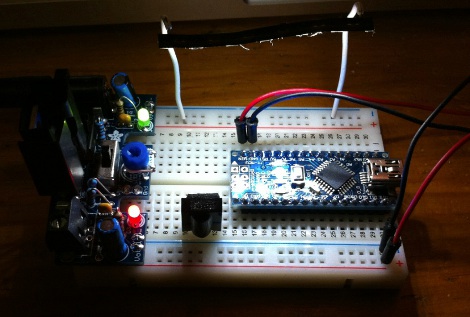
[KaRMaN] sent us a piece from his blog on what to do with a busted iPhone (google translate). As many iPhone owners have found out, it does not take that much of a fall to render your shiny hand-held command center into a pile of shattered glass. Replacement parts and insurance are available so life goes on, but what else can you do?
One thing you could do if your screen split apart like [KaRMaN]’s is remove the white LED back light strip from the device and reuse it. Once he removed the LED he had to repair a couple of traces but that is no big deal. Then the strip is probed to see how the individual LED’s are situated, in this case is 6 in series. The strip is hooked up to a 12v power source and now you have a small, but bright light for some midnight hacking.















i’d like to know more about that add-on on the left side of his breadboard…anyone familiar with that? i’m assuming its some sort of power management board…
Should be this: http://www.adafruit.com/products/184
thanks! that thing is kinda awesome, makes me want to whip one up myself – sick of having a basket of hacked up wall warts sittin around for that purpose
Yoink. That thing is awesome.
Best use for iPhone ever… And at the same time it’s the most pricey desk light ever.
” does not take that much of a fall to render your shiny hand-held command center into a pile of shattered glass.”
This is one of the reasons i don’t buy an iphone(it’s mainly because it doesn’t represent me)…
My phones have been hit, dropped, buried, thrown in the pool(along with me) and the only time i needed a service was to reverse a software update which screwed up the phone.
Still, i wouldn’t call this an expensive light because of where the leds come from(as they are just recovered parts) but because of the rest of the parts used…
I am a bit confused about how the 6 leds connected in series require only 12V. maybe there are two series of three each connected in parallel?
The LEDs must have a 2V forward voltage drop, six of which in series sum to 12V.
As or your hypothesis, it’s unlikely: LEDs should never be connected in parallel (to one another) because they’re non-linear devices, and their I-V curves vary from unit to unit even among identical parts. Connecting them in parallel will therefore result in an over-current condition for one of the diodes due to a (slightly) lower forward voltage threshold for the other. Only if the LEDs each have their own current-limiting resistor can this work.
So rather than have a bunch of energy-wasting resistors in a design, LEDs should be connected in series with just one limiting resistor or constant-current driver. In virtually all backlit devices this is achieved with a DC-DC converter which steps up (for mobile phones) or down (for laptops) the battery voltage to drive the backlight strip (of LEDs) in the most energy-efficient way.
this one is iLightening
OMG. A PROPER HACK USING AN i DEVICE… IT’S A FIRST
^^
This isn’t a troll, but just to be fair.. I’ve dropped my iphone 3g MANY times, I’ve even dropped it while on a treadmill and the phone fell onto the belt and shot off and slammed into some weight racks.
After a couple years of heavy abuse, the screen has a line of dead pixels and the back plastic case has a crack.
People moan and (usually) assume that the screen or iphone in general is weak but there’s few phones that can stand up to similar abuse.
i’d like to know more about that add-on on the RIGHT side of his board.. the blue board, with a lan or usb port mounted in the right side.. anyone familiar with that?
That’s an Arduino nano, not an addon.
http://www.arduino.cc/en/Main/ArduinoBoardNano
thanks!
I’d like to know if any other phones or screens use led’s like that, I got a couple laying around that I would take apart for a small led strip.
Why destroy a perfectly good phone/screen when you can buy a few surface mount LEDs for next to nothing? It would probably be less work soldering a few LEDs on a bit of scrap PCB than ripping apart a phone and figuring out how it was wired.
I just love to see all the new tweensy based hacks appearing today, Reallying interesting project
small hint for you guys, with that whole backlight plate, you’re able to illuminate an old game gear with some smooth and evenly backlight instead of that old light bulb inside eating all the battery power… if anyone is familiar with repairing these
btw i guess you can pull up the voltage drop to 18 volts. did this, and had no problem with that.. only thing is the typical current limit of 20mA for white leds..
or has anybody some documentation of the actual voltage drop used by the iphone internal supply ic?